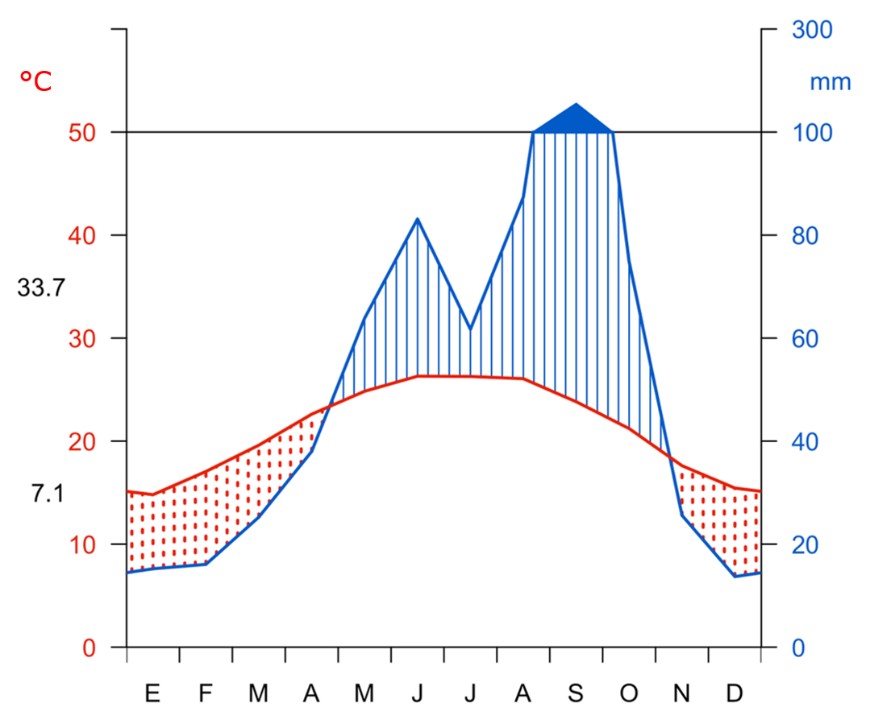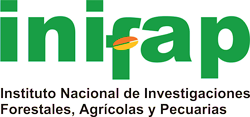Differences in the response of dendroecological indicators to climatic and topographic conditions.
DOI:
https://doi.org/10.29298/rmcf.v15i81.1435Keywords:
Dendroecology, basal area increment, aspect, Pinus arizonicaAbstract
Vegetation dynamics in forest ecosystems are commonly attributed to climatic factors. However, there is still limited knowledge on how topography influences the climatic sensitivity of forest species. The response of dendroecological indicators of Pinus arizonica to topographic exposure and climatic variability was determined. Ring width indices (IAA) and basal area increments (IAB) were obtained. Correlation was calculated between AAI and monthly records of cumulative precipitation (PP) and mean temperatures (Tmax and Tmin) in three periods, 1990-2000 (B1), 2001-2011 (B2) and 2012-2021 (B3). Mann-Whitney and Kruskall-Wallis tests were performed to test for differences in IAB by exposure (northwest, NW and northeast, NE) and by time block, respectively. Tmax limited growth in all three periods, Tmin restricted it in B2 and PP favored it in B1 and B2. Higher IAB was detected in the NO exposure (16.10 cm2) compared to NE (10.66 cm2). There was a significant increase in IAB in the B2 (15.24 cm²) and B3 (15.17 cm²) periods compared to B1 (10.17 cm²). This highlights the importance of considering topography when analyzing climate-growth associations of forest species. Considering the interaction of climatic factors and microclimates associated with site-specific topography generates an integral vision of ecological processes. This allows proposing better forest management strategies to mitigate the effects of climate change.
Downloads
References
Acosta-Hernández, A. C., M. Pompa-García and J. J. Camarero. 2017. An updated review of dendrochronological investigations in Mexico, a megadiverse country with a high potential for Tree-Ring Sciences. Forests 8(5):160. Doi: 10.3390/f8050160. DOI: https://doi.org/10.3390/f8050160
Allen, C. D., A. K. Macalady, H. Chenchouni, D. Bachelet, … and N. Cobb. 2010. A global overview of drought and heat-induced tree mortality reveals emerging climate change risks for forests. Forest Ecology and Management 259(4):660-684. Doi: 10.1016/j.foreco.2009.09.001. DOI: https://doi.org/10.1016/j.foreco.2009.09.001
Breshears, D. D., J. W. Nyhan, C. E. Heil and B. P. Wilcox. 1998. Effects of woody plants on microclimate in a semiarid woodland: Soil temperature and evaporation in canopy and intercanopy patches. International Journal of Plant Sciences 159(6):1010-1017. Doi: 10.1086/314083. DOI: https://doi.org/10.1086/314083
Bunn, A. G. 2008. A dendrochronology program library in R (dplR). Dendrochronologia 26(2):115-124. Doi: 10.1016/j.dendro.2008.01.002. DOI: https://doi.org/10.1016/j.dendro.2008.01.002
Cook, E. R. and R. L. Holmes. 1986. Appendix 2: Users manual for program ARSTAN. In: Holmes, R. L., R. K. Adams and H. C. Fritts. Tree-ring chronologies of western North America: California, eastern Oregon and northern Great Basin with procedures used in the chronology development work including users manuals for computer programs COFECHA and ARSTAN. Laboratory of Tree-Ring Research, University of Arizona. Tucson, AZ, United States of America. pp. 50-65.
Diao, Y., S. Zhang, Y. Liu, G. Jin, S. Tian and Y. Liu. 2023. Effects of topography on radial growth of tree species with different mycorrhizal types. Forests 14(3):546. Doi: 10.3390/f14030546. DOI: https://doi.org/10.3390/f14030546
Eilmann, B., M. Dobbertin and A. Rigling. 2013. Growth response of Scots pine with different crown transparency status to drought release. Annals of Forest Science 70:685-693. Doi: 10.1007/s13595-013-0310-z. DOI: https://doi.org/10.1007/s13595-013-0310-z
Farjon, A., J. A. Pérez de la Rosa and B. T. Styles. 1997. A field guide to the pines of Mexico and Central America. Royal Botanic Gardens. Richmond, LDN, England. 147 p.
Fritts, H. C. 2001. Tree rings and climate. Blackburn Press. Caldwell, NJ, United States of America. 567 p.
González-Cásares, M., M. Pompa-García and J. J. Camarero. 2017. Differences in climate-growth relationship indicate diverse drought tolerances among five pine species coexisting in Northwestern Mexico. Trees 31:531-544. Doi: 10.1007/s00468-016-1488-0. DOI: https://doi.org/10.1007/s00468-016-1488-0
González-Tagle, M. A., J. Cerano-Paredes, W. Himmelsbach, E. Alanís-Rodríguez and Á. A. Colazo-Ayala. 2023. Fire records based on dendrochronological techniques for a coniferous forest in the southeastern region of Jalisco, Mexico. Revista Chapingo Serie Ciencias Forestales y del Ambiente 29(1):35-50. Doi: 10.5154/r.rchscfa.2022.03.018. DOI: https://doi.org/10.5154/r.rchscfa.2022.03.018
Grissino-Mayer, H. D. 2001. Evaluating crossdating accuracy: A manual and tutorial for the computer program COFECHA. Tree-Ring Research 57(2):205-221. https://www.ltrr.arizona.edu/~ellisqm/outgoing/dendroecology2014/readings/Grissino_mayer_COFECHA_2001.pdf. (20 de septiembre de 2023).
Harris, I., T. J. Osborn, P. Jones and D. Lister. 2020. Version 4 of the CRU TS monthly high-resolution gridded multivariate climate dataset. Scientific Data 7:1-18. Doi: 10.1038/s41597-020-0453-3. DOI: https://doi.org/10.1038/s41597-020-0453-3
Hood, S. M., D. R. Cluck, B. E. Jones and S. Pinnell. 2018. Radial and stand-level thinning treatments: 15-year growth response of legacy ponderosa and Jeffrey pine trees. Restoration Ecology 26(5):813-819. Doi: 10.1111/rec.12638. DOI: https://doi.org/10.1111/rec.12638
Intergovernmental Panel on Climate Change (IPCC). 2023. Climate Change 2023: Synthesis Report, Contribution of Working Groups I, II and III to the Sixth Assessment Report of the Intergovernmental Panel on Climate Change. IPCC, World Meteorological Organization (WMO) and United Nations Environment Programme (UNEP). Geneva, GE, Switzerland. 184 p.
Lévesque, M., L. Walthert and P. Weber. 2016. Soil nutrients influence growth response of temperate tree species to drought. Journal of Ecology 104(2):377-387. Doi: 10.1111/1365-2745.12519. DOI: https://doi.org/10.1111/1365-2745.12519
National Hurricane Center (NHC) and Central Pacific Hurricane Center (CPHC). 2023. NHC Data Archive, Tropical Cyclone Reports (TCRs). National Oceanic and Atmospheric Administration (NOOA). https://www.nhc.noaa.gov/data/#tcr. (20 de septiembre de 2023).
Patil, I. 2021. statsExpressions: R Package for Tidy Dataframes and Expressions with Statistical Details. Journal of Open Source Software 6(61):3236. Doi: 10.21105/joss.03236. DOI: https://doi.org/10.21105/joss.03236
Pompa-García, M., M. González-Cásares, A. C. Acosta-Hernández, J. J. Camarero and M. Rodríguez-Catón. 2017. Drought influence over radial growth of Mexican conifers inhabiting mesic and xeric sites. Forests 8(5):175. Doi: 10.3390/f8050175. DOI: https://doi.org/10.3390/f8050175
Pyatt, J. C., D. F. Tomback, S. C. Blakeslee, M. B. Wunder, … and H. D. Bevency. 2016. The importance of conifers for facilitation at treeline: Comparing biophysical characteristics of leeward microsites in Whitebark Pine Communities. Arctic, Antarctic, and Alpine Research 48(2):427-444. Doi: 10.1657/AAAR0015-055. DOI: https://doi.org/10.1657/AAAR0015-055
R Core Team. 2021. R: A language and environment for statistical computing (version 4.0.3). Vienna, W, Austria. R Foundation for Statistical Computing.
Resler, L. M., D. R. Butler and G. P. Malanson. 2005. Topographic shelter and conifer establishment and mortality in an alpine environment, Glacier National Park, Montana. Physical Geography 26(2):112-125. Doi: 10.2747/0272-3646.26.2.112. DOI: https://doi.org/10.2747/0272-3646.26.2.112
Rubio-Cuadrado, Á., C. Gómez, J. Rodríguez-Calcerrada, R. Perea, … and L. Gil. 2021. Differential response of oak and beech to late frost damage: an integrated analysis from organ to forest. Agricultural and Forest Meteorology 297:108243. Doi: 10.1016/j.agrformet.2020.108243. DOI: https://doi.org/10.1016/j.agrformet.2020.108243
Schad, P. 2023. World Reference Base for Soil Resources-Its fourth edition and its history. Journal of Plant Nutrition and Soil Science 186(2):151-163. Doi: 10.1002/jpln.202200417. DOI: https://doi.org/10.1002/jpln.202200417
Stahle, D. W., E. R. Cook, D. J. Burnette, J. Villanueva, … and I. M. Howard. 2016. The Mexican drought atlas: Tree-ring reconstructions of the soil moisture balance during the late pre-Hispanic, colonial, and modern eras. Quaternary Science Reviews 149:34-60. Doi: 10.1016/j.quascirev.2016.06.018. DOI: https://doi.org/10.1016/j.quascirev.2016.06.018
Sundqvist, M. K., N. J. Sanders and D. A. Wardle. 2013. Community and ecosystem responses to elevational gradients: Processes, mechanisms, and insights for global change. Annual Review of Ecology, Evolution, and Systematics 44:261-280. Doi: 10.1146/annurev-ecolsys-110512-135750. DOI: https://doi.org/10.1146/annurev-ecolsys-110512-135750
Urrutia-Jalabert, R., J. Barichivich, V. Rozas, A. Lara, … and E. Cuq. 2021. Climate response and drought resilience of Nothofagus obliqua secondary forests across a latitudinal gradient in south-central Chile. Forest Ecology and Management 485:118962. Doi: 10.1016/j.foreco.2021.118962. DOI: https://doi.org/10.1016/j.foreco.2021.118962
Vicente-Serrano, S. M., S. Beguería and J. I. López-Moreno. 2010. A multiscalar drought index sensitive to global warming: the Standardized Precipitation Evapotranspiration Index. Journal of Climate 23(7):1696-1718. Doi: 10.1175/2009JCLI2909.1. DOI: https://doi.org/10.1175/2009JCLI2909.1
Vitali, A., J. J. Camarero, M. Garbarino, A. Piermattei and C. Urbinati. 2017. Deconstructing human-shaped treelines: Microsite topography and distance to seed source control Pinus nigra colonization of treeless areas in the Italian Apennines. Forest Ecology and Management 406:37-45. Doi: 10.1016/j.foreco.2017.10.004. DOI: https://doi.org/10.1016/j.foreco.2017.10.004
VoorTech Consoulting. 2021. The tree ring measuring program project J2X. (V5.03). Holderness, NH, United States of America. VoorTech. http://www.voortech.com/projectj2x/. (22 de septiembre de 2023).

Published
How to Cite
Issue
Section
License
Copyright (c) 2024 Revista Mexicana de Ciencias Forestales

This work is licensed under a Creative Commons Attribution-NonCommercial 4.0 International License.
The authors who publish in Revista Mexicana de Ciencias Forestales accept the following conditions:
In accordance with copyright laws, Revista Mexicana de Ciencias Forestales recognizes and respects the authors’ moral right and ownership of property rights which will be transferred to the journal for dissemination in open access.
All the texts published by Revista Mexicana de Ciencias Forestales –with no exception– are distributed under a Creative Commons License Attribution-NonCommercial 4.0 International (CC BY-NC 4.0), which allows third parties to use the publication as long as the work’s authorship and its first publication in this journal are mentioned
The author(s) can enter into independent and additional contractual agreements for the nonexclusive distribution of the version of the article published in Revista Mexicana de Ciencias Forestales (for example, include it into an institutional repository or publish it in a book) as long as it is clearly and explicitly indicated that the work was published for the first time in Revista Mexicana de Ciencias Forestales.
For all the above, the authors shall send the form of Letter-transfer of Property Rights for the first publication duly filled in and signed by the author(s). This form must be sent as a PDF file to: ciencia.forestal2@inifap.gob.mx
This work is licensed under a Creative Commons Attribution-Noncommercial 4.0 International license.





